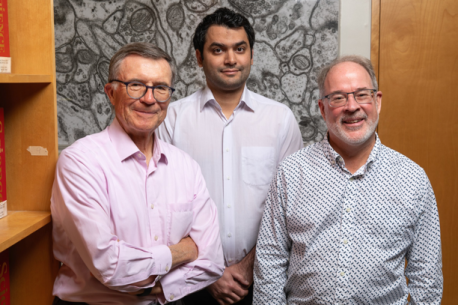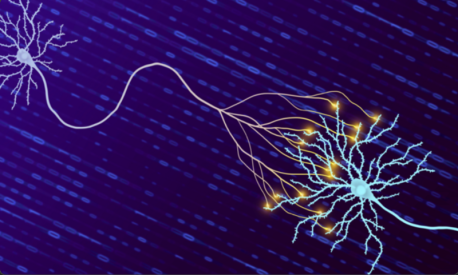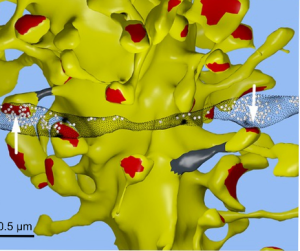
May 22, 2024
Salk scientists develop new technique to measure synapse strength and plasticity, supporting new research on learning and memory and how these processes decline in aging and disease
Salk scientists develop new technique to measure synapse strength and plasticity, supporting new research on learning and memory and how these processes decline in aging and disease
LA JOLLA—With each flip you make through a deck of vocabulary word flashcards, their definitions come more quickly, more easily. This process of learning and remembering new information strengthens important connections in your brain. Recalling those new words and definitions more easily with practice is evidence that those neural connections, called synapses, can grow stronger or weaker over time—a feature known as synaptic plasticity.

Quantifying the dynamics of individual synapses can be a challenge for neuroscientists, but recent computational innovations from the Salk Institute may be changing that—and revealing new insights about the brain along the way.
To understand how the brain learns and retains information, scientists try to quantify how much stronger a synapse has gotten through learning, and how much stronger it can get. Synaptic strength can be measured by looking at the physical characteristics of synapses, but it’s much more difficult to measure the precision of plasticity (whether synapses grow weaker or stronger by a consistent amount) and the amount of information a synapse can store.
Salk scientists have established a new method to explore synaptic strength, precision of plasticity, and amount of information storage. Quantifying these three synaptic features can improve scientific understanding of how humans learn and remember, as well as how those processes evolve over time or deteriorate with age or disease. The findings were published in Neural Computation on April 23, 2024.
“We’re getting better at identifying exactly where and how individual neurons are connected to each other, but we still have a lot to learn about the dynamics of those connections,” says Professor Terrence Sejnowski, senior author of the study and holder of the Francis Crick Chair at Salk. “We have now created a technique for studying the strength of synapses, the precision with which neurons modulate that strength, and the amount of information synapses are capable of storing—leading us to find that our brain can store 10 times more information than we previously thought.”

When a message travels through the brain, it hops from neuron to neuron, flowing from the end of one neuron into the outstretched tendrils, called dendrites, of another. Each dendrite on a neuron is covered with tiny bulbous appendages, called dendritic spines, and at the end of each dendritic spine is the synapse—a tiny space where the two cells meet, and an electrochemical signal is transmitted. Different synapses are activated to send different messages.
Some messages activate pairs of synapses, which live near one another on the same dendrite. These synapse pairs are a fantastic research tool—if two synapses have identical activation histories, scientists can compare the strength of those synapses to draw conclusions about the precision of plasticity. Since the same type and amount of information has passed through these two synapses, did they each change in strength by the same amount? If so, their precision of plasticity is high.
The Salk team applied concepts from information theory to analyze synapse pairs from a rat hippocampus—a part of the brain involved in learning and memory—for strength, plasticity, and precision of plasticity. Information theory is a sophisticated mathematical way of understanding information processing as an input traveling through a noisy channel and being reconstructed on the other end.

Crucially, unlike methods used in the past, information theory accounts for the noisiness of the brain’s many signals and cells, in addition to offering a discrete unit of information—a bit—to measure the amount of information stored at a synapse.
"We divided up synapses by strength, of which there were 24 possible categories, then compared special synapse pairs to determine how precisely each synapses’ strength is modulated,” says Mohammad Samavat, first author of the study and a postdoctoral researcher in Sejnowski’s lab. “We were excited to find that the pairs had very similar dendritic spine sizes and synaptic strengths, meaning the brain is highly precise when it makes synapses weaker or stronger over time.”
In addition to noting the similarities in synapse strength within these pairs, which translates to a high level of precision of plasticity, the team also measured the amount of information held in each of the 24 strength categories. Despite differences in the size of each dendritic spine, each of the 24 synaptic strength categories held a similar amount (between 4.1 and 4.6 bits) of information.
Compared to older techniques, this new approach using information theory is 1) more thorough, accounting for 10 times more information storage in the brain than was previously assumed, and 2) scalable, meaning it can be applied to diverse and large datasets to gather information about other synapses.
“This technique is going to be a tremendous help for neuroscientists,” says Kristen Harris, a professor at the University of Texas at Austin and an author of the study. “Having this detailed look into synaptic strength and plasticity could really propel research on learning and memory, and we can use it to explore these processes in all different parts of human brains, animal brains, young brains, and old brains.”
Sejnowski says future work by projects like the National Institutes of Health’s BRAIN Initiative, which established a human brain cell atlas in October 2023, will benefit from this new tool. In addition to scientists who catalog brain cell types and behaviors, the technique is exciting for those studying when information storage goes awry—like in Alzheimer’s disease.
In years to come, researchers around the world could use this technique to make exciting discoveries about the human brain’s ability to learn new skills, remember day-to-day actions, and store information short- and long-term.
The paper was also authored by Thomas Bartol of Salk.
The work was supported by the National Science Foundation (DBI-1707356, DBI-2014862, 2219894, IIS-2219979) and the National Institutes of Health (P41GM103712, MH095980-07, MH115556, MH129066).
DOI: 10.1162/neco_a_01659
JOURNAL
Neural Computation
AUTHORS
Mohammad Samavat, Thomas M. Bartol, Kristen M. Harris, Terrence J. Sejnowski
Office of Communications
Tel: (858) 453-4100
press@salk.edu
Unlocking the secrets of life itself is the driving force behind the Salk Institute. Our team of world-class, award-winning scientists pushes the boundaries of knowledge in areas such as neuroscience, cancer research, aging, immunobiology, plant biology, computational biology and more. Founded by Jonas Salk, developer of the first safe and effective polio vaccine, the Institute is an independent, nonprofit research organization and architectural landmark: small by choice, intimate by nature, and fearless in the face of any challenge.